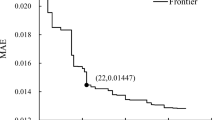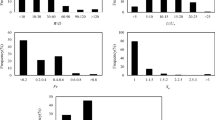Abstract
Transverse mixing coefficient (TMC) is one of the key factors in the modelling of lateral dispersion of pollutants. Several researchers have attempted to estimate this coefficient using various models. However, robust equations that can accurately estimate lateral mixing in both straight and meandering streams are still required. In this study, novel formulae were developed using the hydraulic and geometric parameters of rivers. The multiple linear regression (MLR), genetic programming based symbolic regression (GPSR) and dimensionless parameters were used for this purpose. Two extensive data sets including data from straight channels/streams and meandering ones were employed to develop the formulae. The main advantage of the developed formula for meandering streams is proper consideration of the effects of aspect ratio, friction, and sinuosity. The formulae performances were then compared quantitatively with those of existing ones using accuracy metrics such as RMSE (Root Mean Square Error). The results illustrated that the proposed formulae outperform others in terms of accuracy and can be used for estimating TMC in straight and meandering streams. In addition, the comparison of MLR and GPSR models showed that the latter is marginally more accurate than MLR specially in meandering streams. However, the MLR models presented a more justifiable relationship between the TMC and governing dimensionless parameters. The main advantages of the presented formulae are that they are more accurate than previous models, can be used in both meandering and straight streams; and can be easily implemented in numerical models to estimate the pollutant concentration and mixing length.



Similar content being viewed by others
References
Azamathulla HM, Ahmad Z (2012) Gene-expression programming for transverse mixing coefficient. J Hydrol 434:142–148
Azamathulla HM, Ghani AA (2011) Genetic programming for predicting longitudinal dispersion coefficients in streams. Water Resour Manag 25:1537–1544
Baek KO, Seo IW (2008) Prediction of transverse dispersion coefficient using vertical profile of secondary flow in meandering channels. KSCE J Civ Eng 12:417–426
Baek KO, Seo IW (2011) Transverse dispersion caused by secondary flow in curved channels. J Hydraul Eng 137(10):1126–1134
Baek KO, Seo IW (2013) Empirical equation for transverse dispersion coefficient based on theoretical background in river bends. Environ Fluid Mech 13:465–477
Beltaos S (1979) Transverse mixing in natural streams. Can J Civ Eng 6:575–591
Besio G, Stocchino A, Angiolani S, Brocchini M (2012) Transversal and longitudinal mixing in compound channels. Water Resour Res 48(12):1–15
Boxall JB, Guymer I, Marion A (2003) Transverse mixing in sinuous natural open channel flows. J Hydraul Res 41:153–165
Bruno MS, Muntisov M, Fischer HB (1990) Effect of buoyancy on transverse mixing in streams. J Hydraul Eng 116(12):1484–1494
Cai W, Sen M, Yang KT, Pacheco-Vega A (2005) Genetic-programming-based symbolic regression for heat transfer correlations of a compact heat exchanger. In ASME heat transfer Conf collocated with the ASME Pacific rim technical Conf and exhibition on integration and packaging of MEMS, NEMS, and electronic systems 367-374
Can B, Heavey C (2012) A comparison of genetic programming and artificial neural networks in metamodeling of discrete-event simulation models. Comp and Oper Res 39(2):424–436
Chau KW (2000) Trasverse mixing coefficient measurements in an open rectangular channel. Adv Environ Res 4:287–294
Cramer NL (1985) A representation for the adaptive generation of simple sequential programs. In proceedings of the first intern Conf on genetic algorithms: 183-187
Darwin C (1859) On the origins of species by means of natural selection. Murray, London
Demuren AO, Rodi W (1986) Calculation of flow and pollutant dispersion in meandering channels. J Fluid Mech 172:63–92
Deng ZQ, Singh VP, Bengtsson L (2001) Longitudinal dispersion coefficient in straight rivers. J Hydraul Eng 127:919–927
Dorado J, Rabuñal JR, Pazos A, Rivero D, Santos A, Puertas J (2003) Prediction and modeling of the rainfall-runoff transformation of a typical urban basin using ANN and GP. Appl Arti l Intell 17:329–343
Elder JW (1959) The dispersion of marked fluid in turbulent shear flow. J Fluid Mech 5:544–560
Etemad-Shahidi A, Rohani MS (2012) Prediction of scour at abutments using piecewise regression. Proc ICE-Water Manag 167(2):79–87
Etemad-Shahidi A, Taghipour M (2012) Predicting longitudinal dispersion coefficient in natural streams using M5′ model tree. J Hydraul Eng 138(6):542–554
Fallah-Mehdipour E, Haddad OB, Mariño MA (2014) Genetic programming in groundwater modeling. J Hydrol Eng 19(12):04014031
Fischer HB (1969) The effect of bends on dispersion in streams. Water Resour Res 5(2):496–506
Fischer HB (1973) Longitudinal dispersion and turbulent mixing in open-channel flow. Annu Rev Fluid Mech 5(1):59–78
Fischer HB, Park M (1967) Transverse mixing in a sand-bed channel. Geol Surv Res 500:267–272
Fischer HB, List EJ, Koh RCY, Imberger J, Brooks NH (1979) Mixing in inland and coastal waters. Academic Press, New York
Gandomi AH, Alavi AH, Ryan C (2015) Handbook of genetic programming applications. Springer, Switzerland
Gharbi S, Verrette JL (1998) Relation between longitudinal and transversal mixing coefficients in natural streams. J Hydraul Res 36(1):43–54
Giustolisi O (2004) Using genetic programming to determine {Chezy} resistance coefficient in corrugated channels. J Hydroinf 6:157–173
Hadadpour S, Etemad-Shahidi A, Kamranzad B (2013) Wave energy forecasting using artificial neural networks in the Caspian Sea. Proc ICE-Maritime Eng 167(1):42–52
Heard SB, Gienapp CB, Lemire JF, Heard KS (2001) Transverse mixing of transported material in simple and complex stream reaches. Hydrobiol 464:207–218
Holley ER, Abraham G (1973) Laboratory studies on transverse mixing in rivers. J Hydraul Res 11:219–253
Jafari E, Etemad-Shahidi A (2012) Derivation of a new model for prediction of wave overtopping at rubble mound structures. J Waterw Port Coastal Ocean Eng 138:42–52
Jeon TM, Baek KO, Seo IW (2007) Development of an empirical equation for the transverse dispersion coefficient in natural streams. Environ Fluid Mech 7:317–329
Kalra R, Deo MC (2007) Genetic programming for retrieving missing information in wave records along the west coast of India. Applied Ocean Res 29:99–111
Kazeminezhad MH, Etemad-Shahidi A, Yeganeh-Bakhtiary A (2010) An alternative approach for investigation of the wave-induced scour around pipelines. J Hydroinf 12:51–65
Koza JR (1992) Genetic programming: on the programming of computers by means of natural selection. MIT press
Koza JR, Poli R (2005) Genetic programming. In: Burke EK, Kendall G (eds) Search methodologies: introductory tutorials in optimization and decision support techniques. Springer- Verlag, New York, pp 127–164
Krishnappan BG, Lau YL (1977) Transverse mixing in meandering channels with varying bottom topography. J Hydraul Res 15:351–370
Lau YL, Krishnappan BG (1981) Modeling transverse mixing in natural streams. J Hydraul Div 107(2):209–226
Lee M, Seo W (2013) Spatially variable dispersion coefficients in meandering channels. J Hydraul Eng 193(2):141–153
Montgomery DC, Peck EA, Vining GG (2012) Introduction to linear regression analysis. John Wiley & Sons. http://as.wiley.com/WileyCDA/WileyTitle/productCd-0470542810.html
Naoum S, Tsanis IK (2004) Orographic precipitation modeling with multiple linear regression. J Hydrologic Eng 9(2):79–102
Pilechi A, Mohammadian A, Rennie CD, Zhu DZ (2016) Efficient Method for Coupling Field Data and Numerical Modeling for the Estimation of Transverse Mixing Coefficients in Meandering Rivers J Hydraul Eng:04016009
Rutherford JC (1994) River mixing. Chichester, Wiley
Sattar A, Gharebaghi B (2015) Gene expression models for prediction of longitudinal dispersion coefficient in streams. J Hyrol 524:687–596
Sayre WW, Chang FM (1969) A laboratory investigation of open channel dispersion processes for dissolved, suspended, and floating dispersants. United States Geological Survey
Schmidt MD, H Lipson (2009) Solving iterated functions using genetic programming. In Proceedings of the 11th Annual Conf Companion on Genetic and Evolutionary Computation Conf Late Breaking Papers ACM:2149–2154
Seo I, Baek KO, Jeon TM (2006) Analysis of transverse mixing in natural streams under slug tests. J Hydraul Res 44:350–362
Sharma H, Ahmad Z (2014) Transverse mixing of pollutants in streams: a review. Can J Civ Eng 41(5):472–482
Sinnakaudan SK, Ghani AA, Ahmad MS, Zakaria NA (2006) Multiple linear regression model for total bed material load prediction. J Hydraul Eng 132(5):521–528
Tabatabaei SH, Heidarpour M, Ghasemi M, Hoseinipour EZ (2013) Trasverse mixing coefficient on dunes with vegetation on a Channel Wall. World Environ Water Resour Congr ASCE 1903–1911
Ustoorikar K, Deo MC (2008) Filling up gaps in wave data with genetic programming. Mar Struct 21(2):177–195
Vladislavleva EJ, Smits GF, Den Hertog D (2009) Order of nonlinearity as a complexity measure for models generated by symbolic regression via pareto genetic programming. Evolutionary Computation IEEE Transactions on 13(2):333–349
Walker M (2001) Introduction to genetic programming. University of Montana, Tech Np
Webel G, Schatzmann M (1984) Transverse mixing in Open Channel flow. J Hydraul Eng 110(4):423–435
Yotsukura N, Sayre WW (1976) Transverse mixing in natural channels. Water Resour Res 12(4):695–704
Yotsukura N, Fischer HB, Sayre WW (1970) Measurement of mixing characteristics of the Missouri River between Sioux City, Iowa, and Plattsmouth. Nebraska, US Geological Survey Water-Supply, pp 1–29
Zeng YH, Huai WX (2014) Estimation of longitudinal dispersion coefficient in rivers. J Hydro-Environment Res 8(1):2–8
Author information
Authors and Affiliations
Corresponding author
Rights and permissions
About this article
Cite this article
Aghababaei, M., Etemad-Shahidi, A., Jabbari, E. et al. Estimation of Transverse Mixing Coefficient in Straight and Meandering Streams. Water Resour Manage 31, 3809–3827 (2017). https://doi.org/10.1007/s11269-017-1708-4
Received:
Accepted:
Published:
Issue Date:
DOI: https://doi.org/10.1007/s11269-017-1708-4




